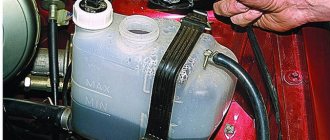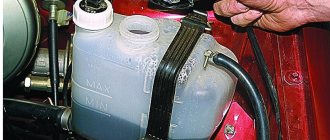How many kg are in 1 liter?
1 l – 917 g. Buckets (12 l) – 11 kg. Cubic meter – 917 kg. Glasses (250 ml) – from 12 to 113 g.
Interesting materials:
In what year was the children's helpline founded in Russia? In what year was the city of Mariupol founded? In what year was the city of Stavropol founded? In what year was the Jesuit order founded? In what year was Tselinograd founded? In what year was the magazine Funny Pictures founded? In what year was the sea route to India opened? In what year was income tax abolished? In what year was Zhdanov renamed to Mariupol? In what year was the first World Hockey Championship?
What does the current fuel density depend on?
The current density of diesel fuel depends on its brand and temperature. You can find out its density at a temperature of 15 or 20 degrees Celsius in the quality certificate.
The higher the temperature of the oil product, the less 1 liter will weigh, and the volume of a kilogram of fuel will increase.
To check whether the density of diesel fuel corresponds to the data specified in the quality passport, you need to take a liter of diesel fuel, weigh it and place it in the temperature environment in which the manufacturer conducted density tests: +150C or +200C. The exact weight of the fuel must be divided by its volume. We get the current density and compare it with the passport data.
Density of different types of diesel fuel
All diesel fuel is divided into different types and is not standard. There are at least three types: summer, winter, arctic fuel. The density is different, and in order to calculate how many liters of diesel fuel are in 1 ton, we need to know this value.
So, summer diesel fuel has a density of 860 kg/m3. This diesel fuel is distinguished by its operating temperature range. At 10 degrees above zero, this fuel may begin to solidify. The temperature at which a flash is possible is 45 degrees above zero. It is usually sold in hot countries.
Winter diesel fuel has a density of 840 kg/m3. It does not harden at temperatures not lower than -35 degrees. Therefore, this fuel is effective in winter. Ignition is possible at 40 degrees Celsius.
There is also Arctic diesel fuel, which is rarely found at gas stations in the city. Its density is 830 kg/m3. It can ignite at 35 degrees Celsius.
If this product is sold in large volumes, the calculation is made in tons, not in liters. This is because liquid can contract or expand at low and high temperatures, respectively. Consequently, the volume will increase or decrease, but the mass will remain constant. Of course, you can buy it in liters, but then there may be a high error for better or worse for the buyer or seller.
How to convert cubes to liters?
How to convert cubes to liters? You will find out the answer to this question by reading this article.
The content of the article:
How to convert cubes to liters?
Students often have difficulty converting one unit of measurement to another. Hence a lot of questions like:
- How many liters are in a cube?
- 1 cubic meter - how many liters is it?
- How many liters are in a cube of water?
- How many liters of gas, propane, gasoline, sand, earth, expanded clay are in a cube?
- How many liters of methane, liquefied gas are in a cube?
- How to convert cm cubed (cm3) or dm cube (cm3) to liters?
- A cube of concrete, gasoline, diesel fuel, diesel fuel - how many liters is that?
Next, we can identify a group of more specific questions, for example, how many liters are in a cube of water, and in a bath? Or how many cubes are in a barrel with a volume of 200 liters, and in a bucket, and in 10 liters? How many cubic meters is 40 liters of dry hydrogen? These questions are relevant both for students when solving various problems, and for practical purposes, for example, when buying some kind of water container. Let’s look into this issue thoroughly, remember, so to speak, the hardware, so that at any moment you can easily convert cubes into liters, and, of course, back.
How many liters are in 1 cubic liter?
Let us first pay attention to the fact that, regardless of the substance placed in the container, the conversion from liters to cubes will always be the same, be it water, gas, sand or gasoline.
How many liters are in 1 cubic liter?
Let's start with a lyrical digression, namely from a school physics course. It is known that the generally accepted unit of volume measurement is the cubic meter. 1 cubic meter is the volume of a cube whose side is exactly one meter.
1 cubic meter
This unit is not always convenient and it is for this reason that others are very often used - liters - also known as cubic decimeters and cubic centimeters.
As practice has shown, the most convenient unit of volume measurement is the liter, which is the volume of a cube whose length is 1 dm or 10 cm. Thus, we find that all the questions of how to convert a dm cube into cubes are equivalent to the question: how to convert liters into cubes, because 1 dm. cube = 1 liter.
1 liter
Formula for converting the volume of a cube into liters
1 cu. m = 1000 l (formula for the volume of a cube in liters)
Formula for converting liters to cubic meters
1 l = 0.001 cu. m
Examples of converting liters to cubes
And now, armed with all the necessary knowledge, we can proceed directly to the calculations.
| Problem #1: How many liters are in 0.5 cubes? Solution: Using the above formula we get: 0.5 * 1000 = 500 liters. Answer: 0.5 cubes contain 500 liters. | Problem #6: How many liters are in 300 cubic meters? Solution: 300 * 1000 = 300,000 liters Answer: There are 300 thousand liters in 300 cubic meters. |
| Problem #2: How many liters are there in 1 cubic meter? (simplest) Solution: 1 * 1,000 = 1,000 liters. Answer: 1 cube contains 1,000 liters. | Problem #7: 5 cubes - how many liters? Solution: 5 * 1000 = 5,000 liters Answer: 5 cubic meters is 5 thousand liters. |
| Problem #3: 2 cubes – how many liters? Solution: 2 * 1,000 = 2,000 liters. Answer: 2 cubes contain 2,000 liters. | Problem #8: 6 cubic meters is how many liters? Solution: 6 * 1000 = 6,000 liters. Answer: 6 cubes contain 6 thousand liters. |
| Problem #4: How many liters are in 10 cubes? Solution: 10 * 1000 = 10,000 liters Answer: 10 cubes contain 10 thousand liters. | Problem #9: How many liters are 4 cubes? Solution: 4 * 1000 = 4,000 liters Answer: 4 cubes contain 4 thousand liters. |
| Problem #5: 20 cubic meters is how many liters? Solution: 20 * 1000 = 20,000 liters Answer: 20 cubes contain 20 thousand liters. | Problem #10: How many liters are 500 cubic meters? Solution: 500 * 1000 = 500,000 liters Answer: There are 500 thousand liters in 500 cubic meters. |
Examples: how to convert cubes to liters?
Let us now consider the inverse problems of finding the number of cubes in the specified number of liters.
| Problem #1: How many cubes are there in 100 liters? Solution: 100 * 0.001 = 0.1 cubic meters meter. Answer: 100 liters is 0.1 cubic meters. | Problem #6: How many cubes are there in 1500 liters? Solution: 1500 * 0.001 = 1.5 cubic meters. Answer: 1500 liters are 1.5 cubic meters. |
| Problem #2: How many cubes are there in 200 liters? Solution: 200 * 0.001 = 0.2 cubic meters meters. Answer: 200 liters are 0.2 meters. | Problem #7: How many cubes are there in 3000 liters? Solution: 3000 * 0.001 = 3 cubic meters. Answer: 3000 liters are 3 cubic meters. |
| Problem #3: How many cubes are there in 140 liters? Solution: 140 * 0.001 = 0.14 cubic meters. Answer: 140 liters are 0.14 cubic meters. | Problem #8: How many cubes are there in 5000 liters? Solution: 5000 * 0.001 = 5 cubic meters. Answer: 5,000 liters are 5 cubic meters. |
| Problem #4: How many cubes are there in 500 liters? Solution: 500 * 0.001 = 0.5 cubic meters. Answer: 500 liters are 0.5 cubic meters. | Problem #9: How many cubes are there in 10,000 liters? Solution: 10,000 * 0.001 = 10 cubic meters m. Answer: in 10,000 liters - 10 cubic meters. m. |
| Problem #5: How many cubes are there in 1000 liters? Solution: 1000 * 0.001 = 1 cubic meter. Answer: 1000 liters are 1 cubic meter. | Problem #10: How many cubes are there in 30,000 liters? Solution: 30,000 * 0.001 = 30 cubic meters m. Answer: in 30,000 liters there are 30 cubic meters. m. |
To make calculations faster, we suggest you use our online calculators:
- cubes to liters conversion calculator
- liters to cubes conversion calculator
Follow the appropriate links and instructions.
If you have any questions on this topic, or you need help in solving the problem of converting cubes to liters or liters to cubes, then leave them below in the comments.
Calculator for converting gasoline from liters to tons
To make it easier to transfer fuel, a special calculator is used. Thanks to it, you can convert liters of any gasoline into tons and calculate the cost per unit. The calculator program can calculate the result if you enter data on the type of fuel and its quantity. Indicators are entered manually or by selecting existing data.
What is it for
The need to recalculate fuel arises among large enterprises and retail chains. The supply of large volumes of fuel is easier if its volume is indicated by tonnage. But for warehouse operations, write-off of fuel when used in transport, and other accounting calculations, an indicator in liters is required.
To prevent mistakes that could cause losses, it is necessary to distinguish between the concepts of mass and volume. A ton is the weight of fuel, i.e. its mass, which is equal to 1000 kg. And displacement is the volume of fuel mass. And due to the density of gasoline, the volume relative to the mass cannot be equivalent.
Odds
It is quite difficult to explain visually the process of the relationship between weight and displacement. But knowing the appropriate fuel units and coefficient, the conversion of gasoline is quite simple. The coefficients are determined in the laboratory; independent calculation is not possible. Therefore, ready-made data for each type of fuel is used for calculations:
| Fuel | Volume (liter) | Weight (ton) per 1 liter | Density (kg/m2) |
| AI-98 | 1000 | 0,776 | 776,0 |
| AI-95 | 1000 | 0,750 | 750,0 |
| AI-92 | 1000 | 0,735 | 735,0 |
Conversion formula
To convert fuel from one indicator to another, you need to turn to physics, where to determine the density (p) you need to know the volume (v) and mass (m). From the reverse, you can get a formula for calculating volume from mass:
v = m / r
Conversely, obtaining tonnage from displacement is carried out according to the formula:
m = v X p
Obtaining data when transferring fuel is not limited to regular formulas. The reason for this is the difference in the measurement system, because weight is expressed in kilograms, and volume in cubic meters. Therefore, it is necessary to determine how many cubic meters make up 1 liter.
1000 l. = 1 m3, which means 1 liter. = 0.001 m3
When the conversion formula and the applied coefficients of different types of fuel are known, a mathematical procedure is performed that allows you to convert gasoline into tons. For example, it is necessary to obtain the mass of 1 liter of AI-98 gasoline. To do this, the calculation is performed as follows:
1 x 0.001x 776.0 = 0.776
Using a simple, understandable formula, the fuel indicator, taking into account the density, can be converted into any unit of measurement.
Effect of temperature on mass calculation
There is another important indicator that directly depends on the result of fuel conversion calculations. This indicator is the temperature from which the density of the fuel changes. It is known that as the temperature increases, the density decreases, and as the temperature decreases, it increases.
Therefore, calculation using the formula without taking into account the temperature conditions of gasoline storage will be erroneous. GOSTs do not contain density indicators regarding fuel types and temperature fluctuations, but there is a method for calculating it. Thus, the density for a particular fuel has a range depending on its temperature.
Calculating density on your own does not make sense. There are reference books and tables that indicate extreme indicators regarding the temperature regime of all types of fuels and lubricants. It is enough to know the temperature and volume to convert liters of fuel into tons.
Weight of 1 liter of gasoline?
It is reliably known that gasoline is conventionally divided into several categories.
So this substance exists under the markings A-76, A92, A-98, A95. They may differ in some properties from each other. Accordingly, the weight of 1 liter of gasoline is different for each of these categories, even despite the identical displacement. By simple mathematical calculations it has long been found out how much weight 1 liter of each brand of gasoline weighs. So, if we talk about the A-95, then it weighs 750 grams.
Accordingly, 2 liters of A-95 will weigh one and a half kilograms, and so on. At the same time, the A-80 weighs 30 grams less with the same volume of 1 liter. It is noteworthy that the mass of the A-76 is exactly the same as that of the A-80, but only if the temperature of this brand of gasoline does not exceed 20 degrees Celsius.
The A-98 is considered the heaviest. Its mass is as much as 780 grams per volume of 1 liter. The second heaviest aircraft is the A-92. There are 760 grams per liter.
So we found out how many grams in 1 liter of gasoline are available in each of its most popular brands. However, we must not forget about the other characteristics of gasoline. Thus, the specific gravity of gasoline can change on its own, regardless of the displacement, and all due to the influence of ambient temperature. So, the higher the value the thermometer shows, the lighter the mass of gasoline will become.
There are even special laboratories where the same amount of a substance is placed in different environments, and then they compare how its mass has changed. So, if the ambient temperature is +16, then 1 liter of A-92 weighs 765 grams. It’s strange, because according to the measurements described above, 1 liter of A-92 is equal to 760 grams.
Why has the mass now become a little heavier? It's all about the temperature of the surrounding space. Therefore, no matter how many times the measurement is carried out, the new result may always be slightly different from the previous one. A more complete picture emerges if you purposefully take measurements with a consistent increase or decrease in temperature. Then you will be able to correctly determine what the density of gasoline is.
In the modern world, people buy gasoline, paying attention to the displacement last. Most of them fill the car's fuel tank full
At the same time, the amount of displacement may vary depending on the type of car and its configuration.
They also often buy gasoline in cans so that they always have a reserve in case the gas tank is empty and the nearest gas station is too far away. So, if you have a 19-liter canister, then you can easily find out how much it weighs when empty and when filled with a substance.
If a 19-liter canister is filled to the top with gasoline, then its weight is 16 kilograms 325 grams. As for the empty container, its mass is 2,550 kilograms. If you consider that the weight of one liter of gasoline is 725 grams, then you can easily calculate everything. First, subtract the empty weight from the weight of the full canister. It will be 16.325 – 2.550. The result is 13.775 kilograms.
This means that a 19-liter canister holds 13.775 kilograms of gasoline. It is easy to check this value. It is enough to divide the resulting net weight of gasoline by the mass of 1 liter. That is 13.775 kg / 0.725 kg. It will turn out to be just 19.
Such simple mathematical calculations allow you to find out the mass of gasoline in any canister, regardless of its capacity.
And yet, someone will probably ask why convert one unit to another? What is the use of knowing how many liters of gasoline are needed to make 1 kg? In fact, they do all this for a reason. For those who use these flammable substances, this translation is of particular importance.
In particular, accountants who work with gas stations, logistics companies, etc. constantly encounter it. If you take into account and calculate how much and in what quantities certain bulk and liquid substances, such as gasoline, are stored in the enterprise’s warehouses, then it is often necessary to convert the values.
Thus, converting liters into kilograms is necessary for those who fill out reports, and to make it easier for them to carry out financial calculations and make payments for the wholesale sale of a substance. First of all, this is due to the traditional method of delivery - in a tank with a certain capacity.
However, accounting is always carried out in bulk. In addition, if the product is sold in bulk, it is easier to count everything in tons. That’s why it’s worth knowing how much 1 liter of gasoline weighs, depending on its brand. Otherwise, the calculations would be much more complicated, which could lead to more frequent errors in this arithmetic process.
Main characteristics
- Cetane number.
Cetane is a hydrocarbon contained in diesel fuel, characterized by rapid ignition under the influence of hot compressed air formed in the combustion chamber of a diesel internal combustion engine. The cetane number determines the ignition quality of a diesel engine; it should not be lower than 45 - 50. We can conclude that the higher the cetane number, the faster the fuel will ignite. High-quality diesel fuel has a high paraffin content and a high cetane number.
Oil contains sulfur. The content of sulfur compounds in diesel fuel is strictly regulated. As part of the fight for environmental friendliness of fuel, as well as reducing the wear of internal combustion engine elements, the sulfur content should be reduced to a minimum. However, as the percentage decreases, the lubricating properties of the diesel engine deteriorate, so it is necessary to use special additives. The best performance indicators are considered to be EURO-4 and EURO-5 diesel fuel brands with a sulfur content of up to 0.05%.
How many liters are in a ton (t) of diesel (diesel fuel). Conversion of tons into liters of diesel fuel (diesel fuel, diesel fuel). Calculate how many liters of diesel are in 1 ton (t). And at the same time, find out the number of standard buckets of diesel fuel with a capacity of 10 liters, the number of standard barrels of diesel fuel with a capacity of 200 liters. Tons (abbreviated as tn) are units of measurement of the mass of a substance, liquid, some material or gas. Very popular questions for intelligence are formulated in the spirit of: “what is heavier than a kilogram of metal or a kilogram of hydrogen.” Oddly enough, many people tend to think: one kilogram of iron must clearly weigh more than one kilogram of hydrogen. This is a psychological reaction that has nothing to do with physics. The mass of a substance expressed in weight units (kilograms) does not depend on its chemical composition or consistency. In fact, the state of aggregation of a substance, from the point of view of determining its weight, does not play any role, except for technology: weighing methods and the design of scales. In any case, when weighing a material, liquid or gas, we want to know how much “it” weighs in absolute numbers. And the units of mass can be grams (g, g), kilograms (kg), tons (t). In some cases, the features of which we will not dwell on in this article, we already know the weight of a substance in kilograms or other units of mass measurement, however, it is necessary to find out how much volume this mass occupies. The usual units for measuring the volume of industrial materials, gases, solids or bulk materials, liquids of various compositions are cubic meters (cubic meters, cubes, cubic meters, m3). Most reference books indicate bulk density or (more precisely) volumetric density of substances, measured in units such as tons/m3, kg/m3, g/cm3. Which in itself already implies, “hidden” in the value of the volumetric density of a diesel engine, the ratio of volume and weight (mass). Therefore, you can quite easily find the ratio of the weight of diesel fuel, expressed in tons, and the volume of diesel fuel, expressed in cubes (m3). Such tables of the ratio of diesel mass and volume (tons of diesel fuel and cubic meters of diesel fuel) are published on many websites. It is somewhat more difficult in cases where we need to find out the ratio of the weight of a diesel engine and the volume it occupies, if it is necessary to obtain the volume of diesel fuel calculated not in cubic meters (cubic meters, cubes, m3), but in other units of measurement of the volume of diesel fuel. For example: in liters of diesel (or liter cans of diesel fuel, which is more understandable). Or standard diesel buckets, diesel fuel barrels, diesel cylinders, diesel tanks with a known capacity in liters. In fact, the relationship is between two units of volume, between cubes and liters. (how many liter cans, liters per cubic meter), a very simple proportion. In a cubic meter of any substance, material, any liquid, steam, gas, there will always be the same number of liter cans. Regardless of what kind of substance we are dealing with and what state of aggregation it is in. For solids, structures, mixtures, bulk materials, alloys, any liquids, vapors and gases under different pressures, the ratio: how many liters are in one cube will be constant. How many liters are in a cubic meter of diesel? No matter how hard you try, you can still fit more than 1000 liters of diesel fuel into a cubic meter (1 m3). diesel fuel or less than 1000 liter cans of diesel fuel, you will not succeed. Practice has shown that knowing the proportion of how many liters are in a cubic meter of diesel is rarely used by site visitors. It is more convenient for them not to make their own calculations related to the conversion of liters of diesel fuel into cubes, but to immediately receive a direct, complete and correct answer to the question: how many liters are in one ton of diesel. Even if they have already found the ratio: how many cubic meters (cubes, cubic meters, m3, cubic meters) of diesel fuel are in a ton of diesel fuel. Therefore, for the convenience of site visitors, we have placed a special table (Table 1), which indicates how many liters are in 1 (one) ton of diesel fuel.
Classification of diesel fuel
Today, each country has its own quality standards for diesel fuel, but there are main classification categories that are common to any type of diesel fuel, prescribed in interstate GOSTs 32511-2013 (EN 590:2009), 305-2013 and 2517-2012.
There are low-viscosity fuels (distillate), used for high-speed engines, and residual, low-viscosity fuels. Unlike hydrotreated kerosene-gas oil fractions of discilate fuel, the residual consists of a mixture of fuel oil and kerosene-gas oil fractions.
The main principle of classification is seasonality.
- Summer DT.
It can only be used at positive temperatures. The specific gravity of summer diesel is 860 kg/m3 (the theoretical density of any type of diesel fuel is determined at +20ºС). With increasing temperature, the specific gravity decreases by approximately 0.0007 g/cm3, and with decreasing temperature, it increases accordingly.
At a temperature of -5ºС, the paraffins of summer diesel fuel thicken and clog the system. The use of additives helps delay thickening, but they do not change the increased density of summer fuel at subzero temperatures. Flash point 62ºС.
- Winter DT.
- Arctic DT.
It is recommended to use in the negative temperature range of 45-50ºС. The density of diesel is 830 kg/m3, and the flash point is +35 degrees Celsius. DF A is obtained by dewaxing summer DF or by adding cetane-increasing additives and motor oil to pure kerosene to improve lubricating properties.
Weight of diesel fuel in 1 liter
is approximately 850 g or 0.85 kg
Diesel weight table
Recalculate, find out volumetric weight: physical properties.
Comments, interesting explanations on the question “how many kg does a liter volume weigh” and some additional information on reference data on physical properties. | |||||||||||||
| Type of diesel engine | Temperature range (ºС) | Density (kg/m3) | Specific gravity (g/cm3) | ||||||||||
| Summer | +0 … | 860 | 0,86 | ||||||||||
| Winter | -35… -20 | 840 | 0,84 | ||||||||||
| Arctic | -50…-45 | 830 | 0,83 |
Specific gravity of diesel fuel (diesel fuel)
Conversion of “mass volume” units. unit converter
To begin with, I would like to clarify what is meant by specific gravity (hereinafter referred to as SG) in physics and chemistry, and only then move on to the specific gravity of diesel fuel or, as it is also called, the specific gravity of diesel fuel.
Let's go over the theory.
Fuel Specific Gravity
Specific gravity is the ratio of the weight of any substance in question to its volume, namely weight, and not mass, as many people think. However, there is no particular difference for us here; these are only distinguishable concepts from a scientific point of view and cannot be confused in any way. It has become so common in everyday life that weight is mass.
The specific gravity of a substance can also be expressed through its density: y=p*g
where g is the acceleration of gravity at a specific point in space, it is usually considered equal to 9.81 m/s*s.
The unit of measurement for hydrocarbons is 1 N/m3 (Newton divided by cubic meter).
Fuel density
The density of a fuel is the amount of its mass in kilograms that fits in one cubic meter. This value is not constant and depends on the temperature of the diesel fuel, which has a bad effect on the operation of the car engine if the diesel fuel is of poor quality in terms of density. The higher the temperature of the liquid, the lower its density and vice versa. It is also a known fact that the higher the density of automobile fuel, the heavier its fractional composition. This leads to the fact that the processes of atomization and evaporation of gasoline or diesel fuel are significantly worsened, therefore, various types of deposits occur more intensively in the combustion chambers of the engine and in the fuel system, which over time increasingly complicates the movement of fuel through the system. This also contributes to the formation of carbon deposits on the engine valves.
Specific gravity of diesel fuel
The density of the fuel and, therefore, its specific gravity is measured with a special device called a hydrometer.
According to the current GOST, the following values are accepted for the specific gravity of diesel fuel (for diesel fuel temperature +20C):
the specific gravity of summer diesel fuel must be within 8440 N/m3; the specific gravity of winter diesel fuel is 8240 N/m3
density of summer diesel fuel – 860 kg/m3 density of winter diesel fuel – 840 kg/m3
Arctic diesel fuel density – 830 kg/m3
In practice, if we take into account only high-quality diesel fuel, it turns out that when the temperature of diesel fuel changes by one degree Celsius, its density changes by 0.00075. This coefficient can be used to recalculate the density of diesel fuel under different temperature conditions. But it is worth remembering that at most gas stations the quality of the product leaves much to be desired, and no one knows what impurities are present in it. While the density of pure fuel can be recalculated using this coefficient, the density of impurities in it is not always true.
Weight of 1 liter of diesel fuel (diesel fuel)
Based on the density values of diesel fuel given above, it is easy to calculate the weight of 1 liter of diesel fuel. It will vary from 830 grams to 860 grams, that is, the higher the temperature of the diesel fuel, the lighter 1 liter of it will weigh.










